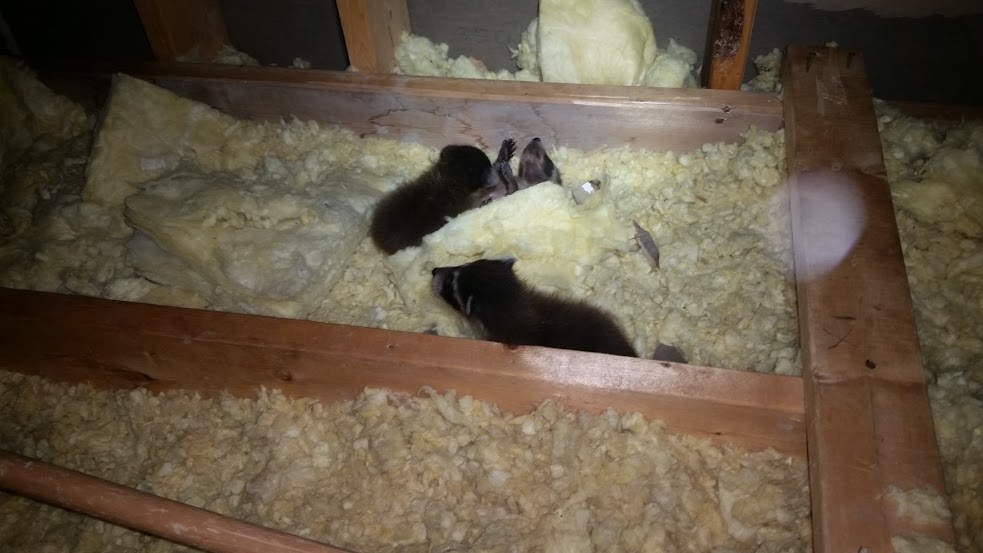Hearing strange noises overhead at night? It might be more than creaky boards—it could be a mother raccoon setting up her nursery in your attic. Warm, quiet, and hidden, an attic is the ideal spot for raccoons, but their presence can cause harm to your home. From damaged insulation to chewed wires and clogged vents, unwelcome wildlife can leave behind costly repairs.
Thankfully, Skedaddle Humane Wildlife Control in Clintonville has you covered. Our humane wildlife removal methods, paired with expert raccoon eviction services, provide attic wildlife solutions that work for both homeowners and animals. We’ll ensure your unwanted guests leave safely while putting measures in place to keep them away for good.
Here’s how we do it—and what you can do to prepare.
Step 1: Inspecting the Attic and Entry Points
The first step? Figuring out how the raccoons got in. Our trained team conducts a thorough inspection, examining both the attic and the exterior of your home from top to bottom.
What We Look For:
- Signs of Activity: Droppings, scratch marks, chewed wires, or shredded insulation often tell us where the raccoons have been hiding.
- Possible Entry Points: These can include loose roof vents, gaps in soffits, or even tiny openings you may not notice. Raccoons are strong and resourceful, so we’re on the lookout for any vulnerabilities they might exploit.
This detective work doesn’t just help us solve the current problem—it also lays the foundation for keeping wildlife out of your home in the future.
Step 2: Humane Removal of the Mother Raccoon
Getting the mother raccoon out is a delicate process, and how it’s done matters just as much as the end result. At Skedaddle, our raccoon eviction services prioritize humane wildlife removal, ensuring both the animals and your home remain safe.
Our Approach:
- We install a one-way door at the entry point. This tool allows the raccoon to leave the attic but blocks her from getting back in.
- The process encourages the mother to find a new, natural habitat for her family without causing her distress.
This method minimizes stress and avoids harsh tactics like live trapping or relocation, ensuring the raccoon leaves on her own terms.
Step 3: Gentle Handling of Baby Raccoons
If there are baby raccoons—or kits—involved, extra care is essential. Since young raccoons can’t leave on their own, our technicians step in to assist.
What We Do:
- Each kit is carefully removed using safe, professional techniques.
- They’re placed in a heated reunion box just outside the home. This specially designed box keeps the babies warm and protected while giving the mother a chance to find and relocate her kits.
This step ensures a successful and compassionate transition for the raccoon family, keeping both the mother and her babies safe.
Step 4: Sealing Entry Points
With the raccoons out, it’s time to make sure they—and other animals—don’t come back. Sealing entry points is a critical part of our attic wildlife solutions.
Key Repairs:
- Fixing loose roof vents and soffits.
- Sealing cracks, gaps, and other potential entryways.
- Using heavy-duty materials that animals can’t chew through.
These repairs not only secure your home but also maintain its appearance. Our goal is to build a strong barrier without compromising your home’s aesthetic.
Step 5: Cleaning and Sanitizing the Attic
Wildlife can leave behind a mess that goes beyond just physical damage. Droppings, urine, and nesting materials can carry bacteria, parasites, or strong odors. Thorough cleaning is essential for restoring your attic.
Our Process:
- Removing droppings and nesting debris.
- Disinfecting the space to eliminate germs and odors.
- Inspecting for hidden damage, like chewed wires or compromised areas, and recommending necessary repairs.
Cleaning doesn’t just improve your attic’s condition—it also removes scents that could attract other animals looking for a home.
Tips for Preventing Future Wildlife Problems
After resolving the immediate issue, the best defense is prevention. Here are some simple tips you can use to keep raccoons—and other creatures—at bay.
- Secure Trash Bins: Use heavy-duty, sealed bins to keep food scraps out of reach.
- Trim Overhanging Branches: Branches near your roof provide easy access for raccoons. Keep them trimmed back to act as a natural barrier.
- Install Chimney Caps and Vent Covers: These structures prevent animals from sneaking inside while maintaining proper airflow.
- Inspect Your Home Regularly: Check for gaps, cracks, or other vulnerabilities that might attract wildlife, and repair them promptly.
Taking these proactive measures can help protect your Clintonville home and avoid the need for repeat interventions.
Why Choose Skedaddle Humane Wildlife Control?
At Skedaddle, we don’t just remove animals—we ensure your home stays safe and wildlife-free for the long haul. Our humane wildlife removal methods prioritize the well-being of both homeowners and animals, creating solutions that work for everyone involved.
Quick Summary of Our Raccoon Eviction Services:
- Comprehensive inspections to identify how wildlife is getting in.
- Humane removal techniques, including one-way doors and heated reunion boxes.
- Long-term attic wildlife solutions like sealing entry points and thorough cleanups.
Your home deserves care and protection, just like the wildlife we share the environment with. Whether you’re worried about a raccoon family in the attic or want to safeguard your home for the future, we have the expertise to help.
Don’t Wait—Take Action Today!
Raccoons in the attic don’t have to mean sleepless nights and costly repairs. With Skedaddle Humane Wildlife Control in Clintonville, you can trust that your home—and the animals—are in good hands.
Our proven methods, from raccoon eviction services to complete attic wildlife solutions, are designed to give you lasting peace of mind. Contact us today for a consultation and take the first step toward a safer, wildlife-free home!



